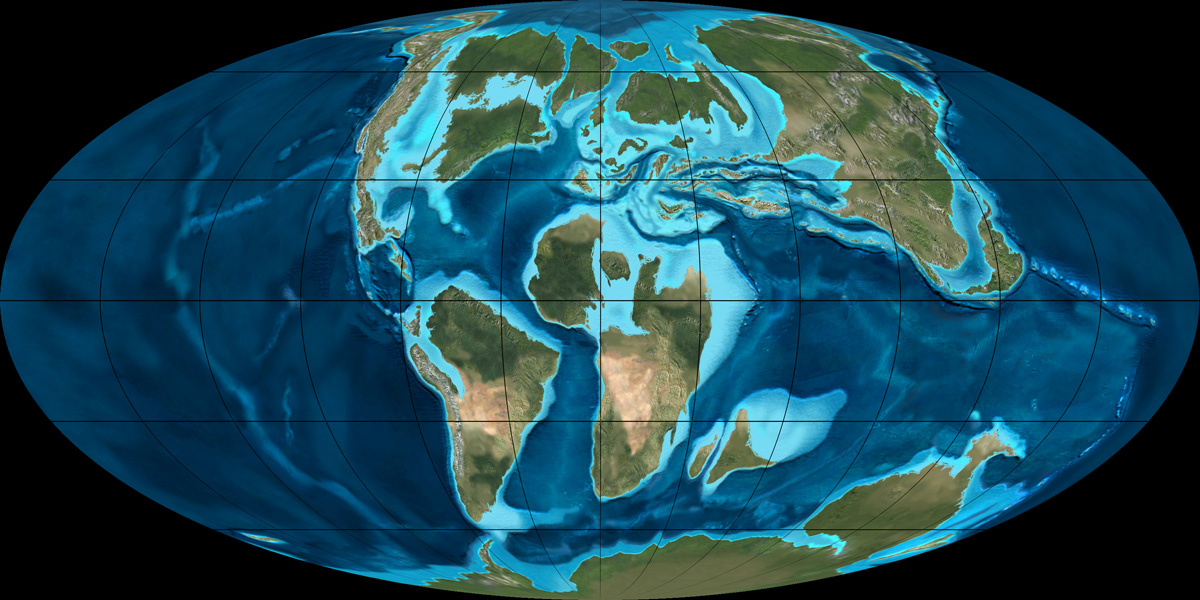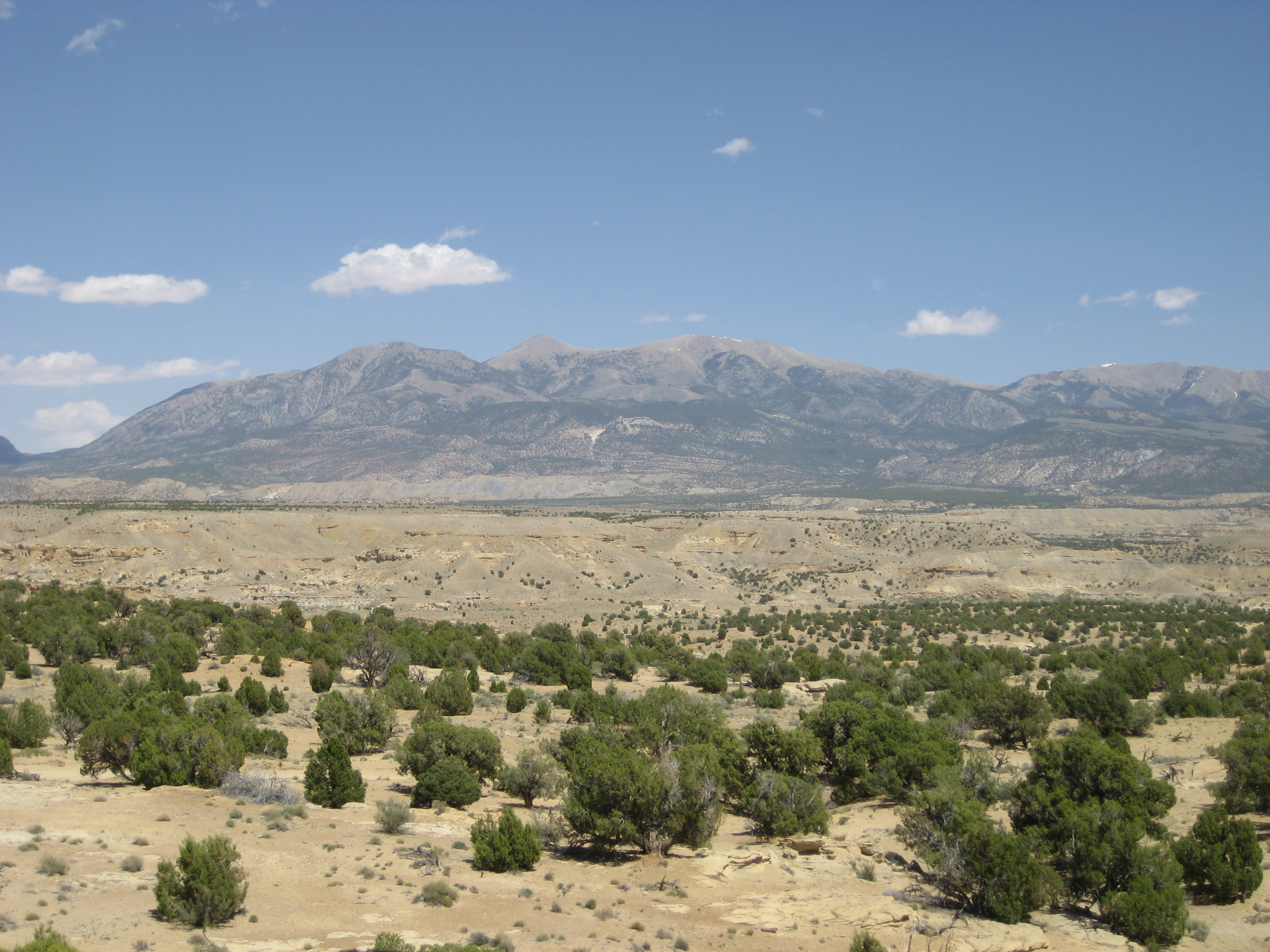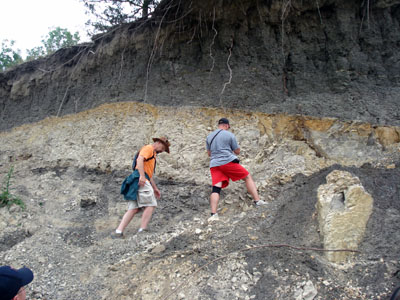Global Events During the Cretaceous
During the Cretaceous, several large-scale events occurred that influenced the environments in Nebraska. A few of these events are described below.
Volcanism and Global Sea Levels
During the Cretaceous, there was an increase in global volcanism and mid-ocean ridge spreading was faster than today. This increased volcanism appears to have resulted from the final breakup of the late Paleozoic-early Mesozoic supercontinent Pangea. The increase in global mid-oceanridge volcanism helped to raise global sea levels, which pushed marine waters up onto the continents. This is how the Western Interior Seaway originated, which flooded Nebraska several times during the Cretaceous. Besides global sea levels being much higher, the planet was hotter overall and little if any ice existed at the poles.
 |
The 90 million year ago global reconstruction from Dr. Ron Blakey. http://jan.ucc.nau.edu/~rcb7/ Note how many continental areas are flooded by marine waters as a result of an increase in mid-ocean ridge volcanism, which is associated with the final break up of the supercontinent, Pangea. |
Chalks
During the Cretaceous, an evolutionary explosion occurred in calcareous nannoplankton, which resulted in chalk deposition across many regions of the world covered with warm marine waters, including flooded areas of the continents. The high abundance of calcareous nannoplankton during the Cretaceous is related to the high global temperatures and low magnesium-calcium ratio of the world's oceans. The famous chalk deposits of southern England formed at the same time as the chalks of Nebraska (i.e. Niobrara Formation) due to this high global abundance of calcareous nannoplankton in warm marine waters across the planet.
| Photograph of the chalk cliffs of southern England, which is the same age as the Niobrara Chalk in Nebraska. The large amount of chalk deposition is related to an abundance of nannoplankton, high global sea levels, and warm global temperatures. Photo by Jesse Koch, University of Nebraska-Lincoln. |
Rocky Mountains
During the Cretaceous, several episodes of mountain building occurred in western North America that helped to shape the environments in Nebraska. Besides pre-existing high global sea levels, the Sevier Orogeny uplifted mountain ranges in western North America, which helped allow marine waters to flood the continent (including Nebraska). Later in the Cretaceous and into the Cenozoic, the Laramide Orogeny helped push up the present-day Rocky Mountains.
 |
A view of the Henry Mountains in Utah, which were uplifted as a result of Mesozoic tectonic activity along the western margin of North America (Sevier and Laramide mountain-building episodes). Photo by Jesse Koch, University of Nebraska-Lincoln. |
Oceanic Anoxic Events
The warm global temperatures during the Mesozoic led to a decrease in the equator-pole temperature gradient. This caused global ocean circulation to slow, which allowed for stagnation and anoxic conditions to form in many parts of the world's oceans. Many of the Oceanic Anoxic Events (OAE's) were widespread and globally synchronous, which suggests the entire ocean circulation system slowed down several times during the Cretaceous. However, these stagnation events allowed for the accumulation of massive amounts of organic matter at the bottom of the world's oceans. Today, many of the rocks around the world that source large amounts of petroleum (i.e. the Middle East) are Jurassic and Cretaceous black shales that formed as OAE's.
One of these OAE events can be seen near the Nebraska-Kansas border separating Cenomanian from Turonian strata within the Greenhorn Limestone. This 2-foot thick dark black shale can be seen at an outcrop along Kansas Highway 36, east of Cuba, KS.
Asteroid Impacts
Besides the famous asteroid impact that ended the Cretaceous Period and killed the dinosaurs, several other impacts occurred during the Cretaceous. Probably the most famous event is the Manson Impact 74 million years ago, when a 1-mile wide asteroid struck central Iowa. This impact cause a tsunami in the Western Interior Seaway, which resulted the deposition of the Crow Creek Member of the Pierre Shale (a tsunami deposit). To learn more about the Manson Impact Structure, click HERE.
 |
The Crow Creek Member (white) with in the Pierre Shale (dark gray/black). This tsunami deposit can be traced across eastern Nebraska, western Iowa, southeastern South Dakota, and southwestern Minnesota. Photo by Dr. Tracy Frank, University of Nebraska-Lincoln. |
For more information about global geologic events during the Cretaceous (as well as other geologic time periods), see: Stanley, S.M., (2008), Earth System History-3rd Edition, Freeman Publishing, 608 pages.